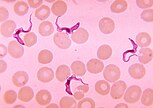
Back Eukarioot Afrikaans Eukaryoten ALS Eukaryota AN حقيقيات النوى Arabic حقيقيات النوى ARZ সংকোষকেন্দ্ৰীয় জীৱ Assamese Eukaryota AST Eukariotlar Azerbaijani Эукариоттар Bashkir Eukaryota BAN
| Eukaryota Temporal range: Statherian–Present
| |
|---|---|
| Scientific classification | |
| Domain: | Eukaryota (Chatton, 1925) Whittaker & Margulis, 1978 |
| Supergroups and kingdoms[2] | |
| Synonyms | |
The eukaryotes (/juːˈkærioʊts, -əts/ yoo-KARR-ee-ohts, -əts) constitute the domain of Eukarya or Eukaryota, organisms whose cells have a membrane-bound nucleus. All animals, plants, fungi, and many unicellular organisms are eukaryotes. They constitute a major group of life forms alongside the two groups of prokaryotes: the Bacteria and the Archaea. Eukaryotes represent a small minority of the number of organisms, but given their generally much larger size, their collective global biomass is much larger than that of prokaryotes.
The eukaryotes seemingly emerged within the Asgard archaea, and are closely related to the Heimdallarchaeia.[5] This implies that there are only two domains of life, Bacteria and Archaea, with eukaryotes incorporated among the Archaea. Eukaryotes first emerged during the Paleoproterozoic, likely as flagellated cells. The leading evolutionary theory is they were created by symbiogenesis between an anaerobic Asgard archaean and an aerobic proteobacterium, which formed the mitochondria. A second episode of symbiogenesis with a cyanobacterium created the plants, with chloroplasts.
Eukaryotic cells contain membrane-bound organelles such as the nucleus, the endoplasmic reticulum, and the Golgi apparatus. Eukaryotes may be either unicellular or multicellular. In comparison, prokaryotes are typically unicellular. Unicellular eukaryotes are sometimes called protists. Eukaryotes can reproduce both asexually through mitosis and sexually through meiosis and gamete fusion (fertilization).
- ^ Cite error: The named reference
Provorawas invoked but never defined (see the help page). - ^ Cite error: The named reference
AdlBass2019was invoked but never defined (see the help page). - ^ Cite error: The named reference
w1990was invoked but never defined (see the help page). - ^ Cite error: The named reference
Margulis 1996was invoked but never defined (see the help page). - ^ Eme, Laura; Tamarit, Daniel; Caceres, Eva F.; Stairs, Courtney W.; De Anda, Valerie; Schön, Max E.; Seitz, Kiley W.; Dombrowski, Nina; Lewis, William H.; Homa, Felix; Saw, Jimmy H.; Lombard, Jonathan; Nunoura, Takuro; Li, Wen-Jun; Hua, Zheng-Shuang; Chen, Lin-Xing; Banfield, Jillian F.; John, Emily St; Reysenbach, Anna-Louise; Stott, Matthew B.; Schramm, Andreas; Kjeldsen, Kasper U.; Teske, Andreas P.; Baker, Brett J.; Ettema, Thijs J. G. (29 June 2023). "Inference and reconstruction of the heimdallarchaeial ancestry of eukaryotes". Nature. 618 (7967): 992–999. Bibcode:2023Natur.618..992E. doi:10.1038/s41586-023-06186-2. ISSN 1476-4687. PMC 10307638. PMID 37316666.







